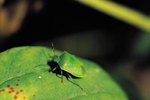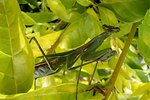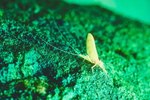
Praying mantises are insects with triangular-shaped heads, and with a stance that make them seem to be praying. The mantises are predators that feed on a wide variety of insects such as the moths, grasshoppers, crickets and flies. They have different body colors depending on their habitat that range from green to pink, with the majority being pea green to brown. The camouflage makes it easy for a mantis to hunt its prey. The typical lifespan of a praying mantis is six months, which can extend to a year.
Eggs
This stage occurs just before winter. The adult female praying mantis lays 100 to 400 eggs after fertilization. The eggs are laid safely on a firm leaf or stem with a liquid that hardens to be a protective sac structure known as ootheca. The ootheca is a protective casing (very hard and able to survive extreme weather changes) in which the eggs will stay throughout the winter. In mid-spring when the temperatures are warm, the nymphs will hatch when the egg cases crack.
Nymphs
Initially, the hatched nymphs stay around the egg casing for a while. It's during this period that the mantis try to feed on each other. After spreading out, they will begin to hunt for small insects such as fruit flies. Nymphs undergo a series of repeated stages of growth in their development known as instars. At each stage, the nymphs shed off their exoskeleton through a process called molting to allow development of body segments leading to an increase in body size. Molting takes place about six times before they can begin the next stage life. Nymphs are vulnerable as prey to other large predators such as the bats, birds and spiders, and not all nymphs survive this stage.
Adolescents
Adolescent mantises are larger in size than nymphs. They shed their exoskeletons occasionally, a feature that differentiates them from adult mantises. Mantises tend to be sluggish before they molt and will rarely feed during this period. Molting increases their vulnerability as prey as it takes a few hours and the mantis remains at one place. The molting process ends at the beginning of summer, when it has grown to be a mature adult.
Adult
Full-grown mantises are normally between 1 to 6 inches in length, and are different in size depending on their species. Female mantises can be distinguished from males as they have heavier abdomens. In addition to small insects, mantises will prey on small nesting birds, mice, lizards and tree frogs. Praying mantises have an interesting behavior when they mate in that the female eats the head of the male mantis as it reduces his sex drive. After mating she feeds on the rest of male’s body. The female mantis usually dies after laying eggs.
References
Photo Credits
-
Jupiterimages/Photos.com/Getty Images
Writer Bio
Kendal Elizabeth has been a professional writer and editor since 2001. She has specialized in writing pet-related topics, home decor and gardening. Her work has appeared on several online and offline publication. Elizabeth holds a Bachelor of Science in Animal Science with a minor in marine biology from Cornell University.



